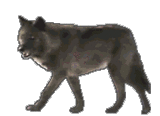|

WOLF GUARDIAN



Fallen Brother:
Another brother has fallen,his mate
sings the song of sadness
The mornful cry's can be heard
through the cold winter's night.
All brothers and sister's gather
to join her in song.
We all mourn the loss as does
his mate.
Soon the pain will leave her but
soon the the song's of sadness
will be for her for she
will never mate again and soon.
The song's of sadness will be
for her,the brothers and
sister's will gather again to sing
the song of sadness for her
for she will not mate again.
Arctic Wolf 12/24/06

Guardian Spirit's
Are watching over the land
More Than 100 Wolves Fall Victim to Alaska's Aerial Gunning Program
January 9, 2004
Aerial Wolf Kill in Alaska
Kerwood Wolf Education Centre Inc.
In just over two months, 143 wolves have been killed in Alaska's controversial aerial-gunning program, which was launched
in late January despite two public votes against it. Hundreds more wolves are scheduled for extermination in the campaign.
At the behest of hunting groups, the Alaska Board of Game is allowing hunters to use aircraft to kill up to 140 (80%)
of the wolves in this 8,000-square-mile area by the end of April. Here, hunters are required to use the land-and-shoot method,
in which they chase down wolf packs using aircraft then, as the wolves collapse from exhaustion, land and shoot them.
The Board of Game has also approved aerial wolf hunting elsewhere, including a 1,700-square-mile area near McGrath, where
hunters are allowed to shoot at least 40 wolves from the air. (To urge the governor to cancel the program, click here.)
The purpose of the wolf-killing plan is to cut down the competition for moose and caribou. Hunters have loudly complained
that wolves eat too many moose calves, leaving too few moose for sport hunting. Some wildlife biologists and conservationists,
however, question Alaska Fish and Wildlife's data on moose population size and demographics. But even if the data were accurate,
the moose population in question has been shown to be at or above the objectives set by the state.
Governor Frank Murkowski's decision to side with trophy hunters and resume the aerial killing of wolves has caused a national
uproar, particularly since Alaska voters have twice (in 1996 and again in 2000) affirmed a long-standing moratorium on aerial
gunning. The governor has brushed aside the criticism by stating that "people who have never visited Alaska imagine wolves
as majestic creatures that shouldn't be touched, but they never look at the majesty of the moose calf, and the right for that
calf to reproduce."
The HSUS has found no record of Murkowski commenting on the rights of a moose with regard to human predation.
Murkowski further justified his stance in the face of negative public opinion: "We've got a state to manage and a
game population to manage, and we've got to do it not on a basis of emotion but on a basis of sound science."
But Murkowski's statements suggest that he himself is overlooking sound science on the role of both predator and prey
in ecosystems and the complexity of the predator-prey relationship. Clearly he, too, is allowing emotion and personal bias
to color his vision of nature, or what he thinks nature ought to be. He, no doubt, is also influenced by the extra revenue
generated by non-resident licenses as well as caribou and moose tags.
|

